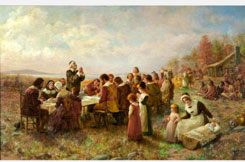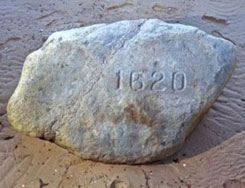Small Planet Communications, Inc. + 15 Union Street, Lawrence, MA 01840 + (978) 794-2201 + Contact







Plymouth Colony was founded in November 1620, when the Mayflower carried a group of Pilgrims to the New World. Landing first at the tip of Cape Cod, the Mayflower sailed on to establish the second English settlement in the New World. The first had been established in Jamestown, Virginia, 13 years earlier. The Pilgrims explored the Massachusetts Bay area for about a month before choosing the site for their settlement. Plymouth Colony was built on the site of an abandoned Wampanoag village named Patuxet.

Map of the Plymouth Colony.
Compare and contrast the first two English colonies at: Jamestown vs. Plymouth.
Their arrival in the New World just as winter was approaching presented problems for the Pilgrims. The group did not have time to obtain adequate food or build warm shelters during the winter of 1620–1621. This brought about many forms of illness, which, for a time, threatened to wipe out the Pilgrim company. Nearly half of the colonists died during that first winter in America.
The Mayflower and its crew members sailed back to England in early 1621, leaving the colonists cut off from their homeland. They were completely dependent upon each other and the American Indians for survival. The need for shelter and food in a strange new environment was an enormous challenge for the colonists. The dread of American Indian attacks and trouble caused by wild animals and insects were things the colonists had not encountered in England or Holland.
Read a biography about
Squanto, a Wampanoag
guide and interpreter for
the Pilgrims.
In spring of 1621, a Wampanoag Indian named Samoset appeared in the settlement. Samoset surprised the colonists by speaking to them in English. Samoset had learned how to speak English from traders whom he had met in an area that is now a part of Maine. He promised the settlers that they did not have to fear being attacked by the Wampanoag and introduced them to his friend Squanto, who had once lived in Patuxet. Squanto had previously been a slave in Europe, but he escaped and returned to America. Squanto became a guide to the Pilgrims, helping them to survive in their new home.
DID YOU KNOW?
The first Thanksgiving dinner was eaten
without the use of forks. 
Learn more about the 1621 Harvest Feast.
By the fall of 1621, the members of Plymouth Colony had gained much knowledge about farming, fishing, and hunting from Squanto and other Wampanoag. In November, the Wampanoag helped the colonists bring in their first crop, and the two groups celebrated with a huge harvest feast. About 90 Wampanoag joined the Pilgrims in eating such foods as turkey, lobster, clams, potatoes, squash, and beans. The Pilgrims did not actually call the celebration Thanksgiving, but it set the stage for the Thanksgiving holiday that has become such an important day to people in America today.
Read The Treaty with
Massasoit, from William
Bradford's Of Plymouth
Plantation.
Samoset also introduced the colonists to Massasoit, the leader of the Wampanoag. Massasoit and John Carver, who was the first governor of the Plymouth Colony, signed a peace treaty that would keep relations between the Wampanoag and the colonists friendly for many years. In Governor William Bradford's Of Plymouth Plantation, Bradford listed the terms of the peace treaty, including the following: "...That neither he nor any of his, should injure or do hurt to any of their people....That if any thing were taken away from any of theirs, he should cause it to be restored; and they should do the like to his....That if any did unjustly war against him, they would aid him..."
Thanks in part to the treaty, Plymouth Colony flourished. Another reason the colony survived was able leadership. When Carver, Plymouth Colony's first governor, died suddenly in April 1621, William Bradford replaced him and went on to govern the colony for more than 30 years. Bradford provided the strong, steady leadership that kept the tiny community alive. He strove to sustain the religious ideals of the founders and to keep the colony's settlements compact and separate from the larger neighboring colonies.
Separate fact from fiction about
Plymouth Rock.

"Here is a stone which the feet of a few
outcasts pressed for an instant; and
the stone becomes famous; it is treasured
by a great nation; its very dust is shared
as a relic." —Alexis DeTocqueville, 1835
With each passing year, Plymouth Colony continued to grow. The population began to rise, aided by the arrival of more ships bringing new settlers. Around the time of the harvest feast, a ship named Fortune brought 35 more colonists to Plymouth. Less than two years later, two more ships came to the colony. Little James and Anne brought another 60 people from England. As Plymouth grew, the colony, which originally had only one street, grew outward, with homes being built away from the center in the surrounding countryside. By the middle of the decade, Plymouth Colony had come a long way from its early days of sickness, hunger, and despair.
A problem arose in 1625 when a group led by Thomas Morton arrived. Morton was an English trader and lawyer who helped found a settlement called Mount Wollaston (present-day Quincy, Massachusetts). The settlement was soon renamed Mare Mount, or Merry Mount. Morton and his fellow settlers offended the deeply-religious Pilgrims of Plymouth Colony by holding boisterous Maypole festivities. Morton further upset the Pilgrims by developing a rival fur trade with American Indians. The Pilgrims sent a military force led by Myles Standish to arrest Morton, and he was sent back to England to face charges of trading arms with American Indians. Morton returned a couple of times to the New England area and wrote New English Canaan, a book criticizing Separatists and Puritans.
By 1627, the colonists had made enough money from the beaver trade that they were able to close out their contract with London merchants (part of the contract prohibited the colonists from working for their own gain) and were able to expand trade with the American Indians. Trading posts were constructed to the north and west, including posts in the Connecticut Valley and along the main rivers in present-day Maine.
Nathaniel Hawthorne turned a bit of
history into a short story entitled
The May-Pole of Merry Mount as part
of his collection of Twice Told Tales.
Plymouth was democratically governed during its first few years, although only people called freemen were allowed to vote. A governing body, along with the governor, enacted laws and levied taxes. The laws were strict by today's terms, but they were fairly reasonable for the time. Few crimes were capital offenses, while lesser offenses were usually dealt with by the paying of fines.
Learn more about life
at the Plimoth Plantation.
In the 1630s, Plymouth Colony expanded greatly. The general economic situation brightened during that time period with the arrival of the much larger and wealthier Massachusetts Bay Company. Suddenly Plymouth's livestock and grain were in great demand. Several new towns were founded, including Scituate, Duxbury, Taunton, Sandwich, and Barnstable.
The following decade, however, was a time of great trouble. The cattle trade disintegrated due to the slowing of new arrivals to the area, causing cattle prices to drop. In 1642, the first English Civil War began, and some colonists went back to England. Other colonists left Plymouth for other regions, such as Nauset on Cape Cod. Colonial expansion into American Indian territories eventually led to disputes between settlers and the American Indians. During this time, Plymouth Colony joined the Massachusetts Bay, Connecticut, and New Haven colonies in forming the New England Confederation. This alliance worked to settle land and boundary disputes and to provide for the common defense.
Visit the Plymouth Colony Archive
Project, sponsored by the University
of Virginia.
Relations between Plymouth Colony and the Wampanoag worsened after the death of Massasoit in 1660. American Indians suspected that colonists killed Massasoit's son, Alexander, in 1662, but Alexander's brother Philip, who became the leader of the Wampanoag, tried to keep peace with the colonists. After a few years of relative calm, relations grew worse as the Wampanoag gave up more and more of their land in exchange for English goods that they wanted. War finally broke out between the Wampanoag and the colonists in 1675. King Philip's War lasted about a year, with the death of Philip in August of 1676 marking the end of the war. The effects of King Philip's War were staggering. The entire Wampanoag tribe was nearly wiped out, along with the fur trade. Because of the New England Confederation's victory over the American Indians in the war, Plymouth Colony survived.
In 1686, King James II of England authorized the merging of Plymouth Colony and the rest of New England, New York, and New Jersey into the Dominion of New England under the governorship of Sir Edmund Andros. The governor taxed the colonists and brought about other measures that upset them, causing some to be jailed for dissent. The Dominion was overthrown in 1689, and Plymouth reestablished its government. Two years later, Plymouth and the more populous and prosperous Massachusetts Bay Colony joined together to form the royal province of Massachusetts Bay. By this time, Plymouth Colony had upwards of 7,500 inhabitants.
Also see The Mayflower
Plymouth | Bibliography
- Encyclopædia Britannica. "New England Confederation." Accessed 5/30/19. http://www.britannica.com/EBchecked/topic/411437/New-England-Confederation
- The History Channel. "Thanksgiving." Accessed 5/30/19. http://www.history.com/topics/thanksgiving
- Houghton Mifflin. "Thomas Morton." Accessed 5/30/19. http://college.cengage.com/english/lauter/heath/4e/students/author_pages/
colonial/morton_th.html - Infoplease. "King Philip's War." Accessed 5/30/19. http://www.infoplease.com/encyclopedia/history/king-philip-war.html
- Infoplease. "Massachusetts." Accessed 5/30/19.
http://www.infoplease.com/us-states/massachusetts.html - Infoplease. "Thomas Morton." Accessed 5/30/19. http://www.infoplease.com/encyclopedia/people/morton-thomas.html
- Pilgrim Hall Museum. "About the Pilgrims: Who Were the Native People." Accessed 5/30/19. http://www.pilgrimhallmuseum.org/ap_who_were_native.htm
- Pilgrim Hall Museum. "Alexis DeTocqueville, 1835." Accessed 5/30/19. http://www.pilgrimhallmuseum.org/pdf/Alexis_de_Tocqueville.pdf
- Pilgrim Hall Museum. "Beyond the Pilgrim Story." Accessed 5/30/19. http://www.pilgrimhallmuseum.org/plymouth_rock.htm
- Pilgrim Hall Museum. "The Treaty with Massasoit." Accessed 5/30/19. http://www.pilgrimhallmuseum.org/pdf/Text_Treaty_with_Massasoit.pdf
- Plimoth Plantation. "Plymouth Colony Time Line." Accessed 5/30/19. https://www.plimoth.org/sites/default/files/media/pdf/historical_timeline.pdf
- Scholastic, Inc. "Plymouth Colony." Accessed 5/30/19. http://teacher.scholastic.com/researchtools/researchstarters/plymouth/
- Scholastic, Inc. "The First Thanksgiving: The Thanksgiving Feast." Accessed 5/30/19. http://www.scholastic.com/scholastic_thanksgiving/feast/
- U.S. Department of State. "Chapter 2: Colonial Era and The Revolutionary War." Accessed 5/30/19. https://photos.state.gov/libraries/amgov/30145/publications-english/history_outline.pdf
Plymouth | Image Credits
- Plymouth Colony Map | Artist: Karl Musser, 2007; Wikimedia Commons
- The First Thanksgiving at Plymouth | Artist: Jennie A. Brownscombe, 1914; Pilgrim Hall Museum
- Plymouth Rock | Destination Plymouth County
© 2020 Small Planet Communications, Inc. + Terms/Conditions + 15 Union Street, Lawrence, MA 01840 + (978) 794-2201 + planet@smplanet.com


